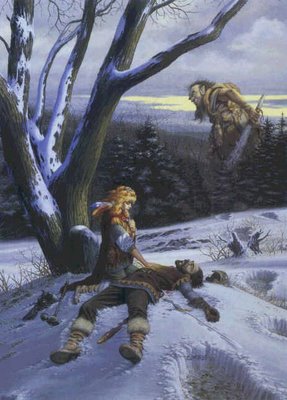It is not known whether the Roth Thane have any direct kinship with the Thanes of the Dragon's Claw Mountains but the savage horse peoples that traverse the Harian Plains have been given the name by those who have encountered them.
The Roth Thane are a stoic, almost brooding people possessed of a spirit that is unshakable and unnerving to those from outside their culture. In battle they ride silently, letting the thunder of their mounts announce their presence alone. None who have battled them can say that they recall the Roth Thane speaking a word.
At home and among their own kind they are, conversely, quite vocal. The Roth Thane have a rich verbal tradition and their own language is divided into at least ten known dialects, one for each of their nine clans and a tenth used only by their shamans. Each of these languages is similar but has unique subtle differences known and mastered only by members of a clan. Clan members learn these nuances as they grow up within the clan to which they are born. Revealing these clan secrets is punishable by banishment and excommunication from the clan.
Through this rich linguistic tradition, the Roth Thane have accumulated a tapestry of intricate tales, songs and stories all used to educate and entertain through the ages. Members of other clans can share in these tales but without knowledge of the clan's linguistic secrets, they will not find full meaning in this.
Roth Thane beliefs state that in their early days a great hydra was summoned by a shaman, fearful for the survival of their kind. The hydra stole all language from the people, leaving them silent and without any way to communicate and would only give them back their words once they had settled their differences through understanding and the more intricate interactions required by the lack of spoken language. But this was not enough for the shaman, who fear that once they had regained their words they would set upon one another once more and so he asked a final favor of the hydra spirit.
As requested by the shaman, when the hydra returned their words to the people, he did so in a manner that made each clan's words slightly different than the others. Though they could share ideas and communicate as a people, no clan would ever fully possess the entirety of the knowledge and teachings of any other clan, making every clan a necessary part of the whole people. Since that time, it has been forbidden to ever kill off a clan. Though it has been tried and some clans have been cut to the quick, always some are allowed to live so that the people will not lose a part of themselves.
The typical Roth Thane is a lanky person, standing about 5' 7" with sinewy arms and legs and a lithe muscular form that allows them great agility in the saddle. Men and women alike are similarly built as both live and ride, fight and hunt. Hair ranges from deep reds to dark walnut browns with black and blond occurring but rarely. Facial hair is not commonly warn and is seen by the Roth Thane as a symbol of evasion or concealment.
Attire is usually limited to simple jerkins and breechclouts made of natural fiber or animal skin. They seldom wear armor save the occasional decorative scrap looted and worn for its appearance
 Widders are a strange sort of psuedo priest and hedge wizard combined, though no Widder would ever concede to such an identity. More so the Widders of veil see themselves as simple wisemen and women, possessed of an acumulated knowledge based on common sense and a straight forward view of the world around them.
Widders are a strange sort of psuedo priest and hedge wizard combined, though no Widder would ever concede to such an identity. More so the Widders of veil see themselves as simple wisemen and women, possessed of an acumulated knowledge based on common sense and a straight forward view of the world around them.